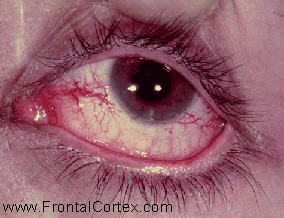Last modified on Saturday, February 17 2007.

Image courtesy of National Eye Institute, National Institutes of Health
A 6 year-old female presents with a history of ataxia of the limbs, dysarthric speech, grimacing, and choreoathetosis, which have been slowly progressing since early childhood.
On exam, you notice the eye findings shown in the image above.
This disorder is associated with a defect on which chromosome?
This patient's history and eye findings are diagnostic for ataxia-telangiectasia. This is associated with a defect of the ATM gene, located on chromosome 11. The specific locus is 11q22-23. (
This patient's history and eye findings are diagnostic for ataxia-telangiectasia. This is associated with a defect of the ATM gene, located on chromosome 11. The specific locus is 11q22-23. (
This patient's history and eye findings are diagnostic for ataxia-telangiectasia. This is associated with a defect of the ATM gene, located on chromosome 11. The specific locus is 11q22-23. (
This patient's history and eye findings are diagnostic for ataxia-telangiectasia. This is associated with a defect of the ATM gene, located on chromosome 11. The specific locus is 11q22-23. (
This patient's history and eye findings are diagnostic for ataxia-telangiectasia. This is associated with a defect of the ATM gene, located on chromosome 11. The specific locus is 11q22-23. (
| 1. Santos, C.C., Miller, V.S., and Roach, E.S. (2004). Neurocutaneous syndromes. In Bradley, W.G., Daroff, R.B., Fenichel, G.M., and Jankovic, J. (Eds.). Neurology in Clinical Practice, 4th Edition. Butterworth Heinemann, Philadelphia. Pp. 1867-1900. | |
| 2. NINDS Ataxia Telangiectasia Information Page, NINDS. http://www.ninds.nih.gov/disorders/a_t/a-t.htm | |
| 3. Victor, M., and Ropper, A.H. (2001). Adams and Victor's Principles of Neurology, 7th Edition. McGraw-Hill, New York. Pp. 1011-1012. | |
























